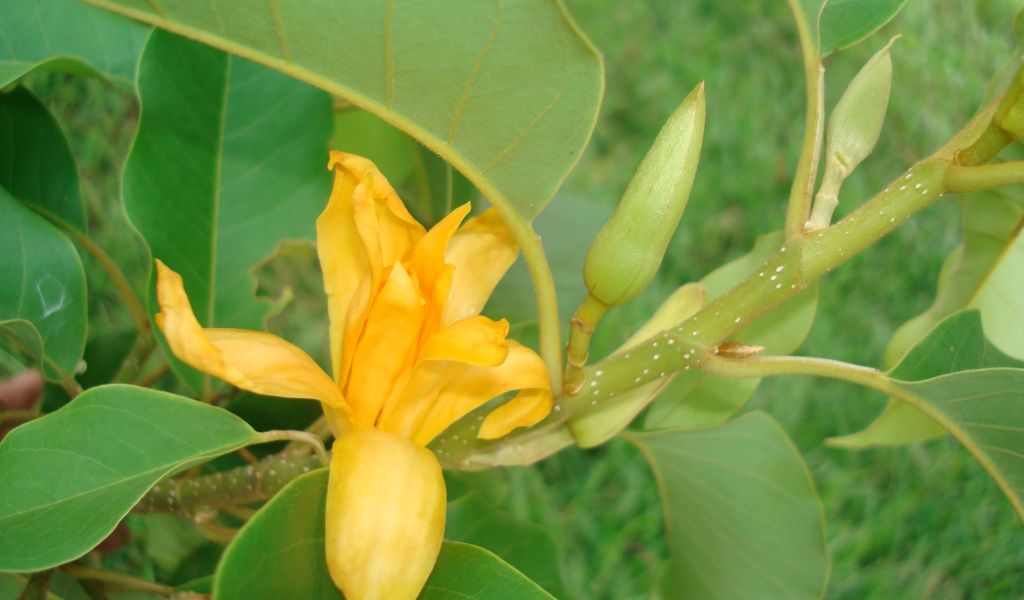ຈໍາປີ / Champak
APA 6th ed. ຈໍາປີ / Champak. (2019, April 3). Retrieved from https://www.phakhaolao.la/kb/0000197
MLA 8th ed. ຈໍາປີ / Champak. Pha Khao Lao, 3 April 2019, https://www.phakhaolao.la/kb/0000197.
Chicago 17th ed. Pha Khao Lao. 2019. "ຈໍາປີ / Champak." Published April 3, 2019. https://www.phakhaolao.la/kb/0000197.

Magnolia champaca var. champaca
Magnolia membranacea P.Parm.
Michelia aurantiaca Wall.
Michelia blumei Steud.
Michelia champaca L.
Michelia champaca var. blumei Moritzi
Michelia euonymoides Burm.f.
Michelia rheedei Wight
Michelia rufinervis DC.
Michelia sericea Pers.
Michelia suaveolens Pers.
Sampacca euonymoides (Burm.f.) Kuntze
Sampacca suaveolens (Pers.) Kuntze
French: Champac
Hindu: Champa, Champe-ke-phul
Khmer: Cham pa
Javanese: Pechari putih
Malay: Cempaka, Chempaka gadin, Chempa putih, Chempaga putih
Sumatran: Champaga putih
Sanskrit: Campakah, Champaka
Thai: Champa, Cham-pa-ko, Champa khao, Champa thong, Champa pa
Vietnamese: Hoàng lan, Ngọc lan hoa vàng, Sứ vàng
Magnolia champaca (L.) Baill. ex Pierre is a medium-size, evergreen tree, attaining a height of about 30 m or more. Bark is thick, gray or brownish, smooth. Leaves alternate, lanceolate or sometimes ovate, margins entire, shiny or glabrous. Inflorescence in axillary, rarely in terminal, solitary, pale to deep yellow, bisexual, spreading agreeable fragrance. Fruits consist of long clusters of capsules on a long spike, dark brown, splitting by two valves. Seeds are brown covered by red aril.
Flowering and fruiting from May to August.
The flowers are used for treating sinusitis, dizzness, chest pain, wooping cough and gonorrhoea or white. The leaves are combined with the leaves of Ficus microcarpa L. f./Ficus retusa L., 30 g each and 5 g of dried earth worm, make up a decoction, this remedy is reported to be good for chronic bronchitis in the elderlies. The stem bark is used for tertian fever, relieving cough, regulating menses. In Cambodia, the decoction of leaves is use as gagarism or mouthwash solution for the treatment of tonsilitis. According to Indian experience, the flowers are used in dyspepsia, nausea, fever and also useful as a diuretic and for healing renal maladies; the essential oil of the flowers is used for cephalagia. The root bark is a purgative and emmenagogue . The flowers and the essential oil distillated from the flowers are marketed for their scent. The oil is used in the production of cosmetics. According to traditonal medicine theory, the root and the fruit possess bitter taste, cool character, shows antirheumatismal and antiinflammatory effects, useful for sorethroat and pain relief. The stem bark is antipyretic, disposing of phlegm and astringent. The fruits have sedative effect, the leaves are antidote.
